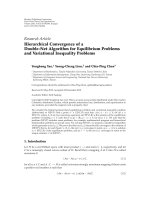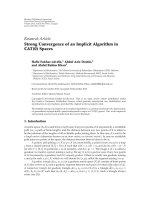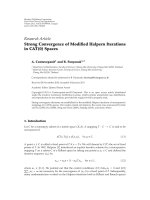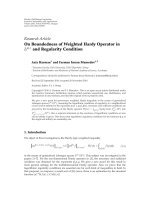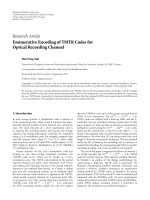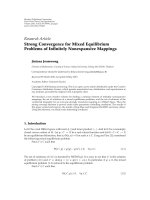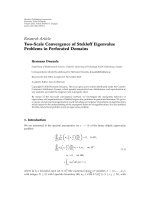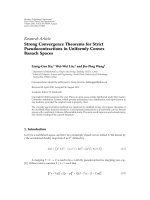báo cáo hóa học:" Research Article Two-Scale Convergence of Stekloff Eigenvalue Problems in Perforated Domains" pot
Bạn đang xem bản rút gọn của tài liệu. Xem và tải ngay bản đầy đủ của tài liệu tại đây (551.61 KB, 15 trang )
Hindawi Publishing Corporation
Boundary Value Problems
Volume 2010, Article ID 853717, 15 pages
doi:10.1155/2010/853717
Research Article
Two-Scale Convergence of Stekloff Eigenvalue
Problems in Perforated Domains
Hermann Douanla
Department of Mathematical Sciences, Chalmers University of Technology, 41296 Gothenbur g, Sweden
Correspondence should be addressed to Hermann Douanla,
Received 31 July 2010; Accepted 11 November 2010
Academic Editor: Gary Lieberman
Copyright q 2010 Hermann Douanla. This is an open access article distributed under the Creative
Commons Attribution License, which permits unrestricted use, distribution, and reproduction in
any medium, provided the original work is properly cited.
By means of t he two-scale convergence method, we investigate the asymptotic behavior of
eigenvalues and eigenfunctions of Stekloff eigenvalue problems in perforated domains. We prove
a concise and precise homogenization result including convergence of gradients of eigenfunctions
which improves the understanding of the asymptotic behavior of eigenfunctions. It is also justified
that the natural local problem is not an eigenvalue problem.
1. Introduction
We are interested in the spectral asymptotics as ε → 0 of the linear elliptic eigenvalue
problem
−
N
i,j1
∂
∂x
i
a
ij
x,
x
ε
∂u
ε
∂x
j
0, in Ω
ε
,
N
i,j1
a
ij
x,
x
ε
∂u
ε
∂x
j
ν
i
λ
ε
u
ε
, on ∂T
ε
,
u
ε
0, on ∂Ω,
ε
S
ε
|
u
ε
|
2
dσ
ε
x
1,
1.1
where Ω is a bounded open set in
N
x
the numerical space of variables x x
1
, ,x
N
,
with integer N ≥ 2 with Lipschitz boundary ∂Ω, a
ij
∈CΩ; L
∞
N
y
1 ≤ i, j ≤ N,with
2 Boundary Value Problems
the symmetry condition a
ji
a
ij
, the period icity hypothesis: for each x ∈ Ω and for every
k ∈
N
one h as a
ij
x, yka
ij
x, y almost everywhere in y ∈
N
y
, and finally the ellipticity
condition: there exists α>0suchthatforanyx ∈
Ω
Re
N
i,j1
a
ij
x, y
ξ
j
ξ
i
≥ α
|
ξ
|
2
1.2
for all ξ ∈
N
and for almost all y ∈
N
y
,where|ξ|
2
|ξ
1
|
2
··· |ξ
N
|
2
.
The set Ω
ε
ε>0 is a domain perforated as follows. Let T ⊂ Y 0, 1
N
be a compact
subset in
N
y
with smooth boundary ∂T≡ S and nonempty interior. For ε>0, we define
t
ε
k ∈
N
: ε
k T
⊂ Ω
,
T
ε
k∈t
ε
ε
k T
,
Ω
ε
Ω\ T
ε
.
1.3
In this setup, T is the reference hole, whereas εk T is a h ole of size ε and T
ε
is the collection
of the holes of the perforated domain Ω
ε
. The family T
ε
is made up with a finite number of
holes since Ω is bounded. Finally, ν ν
i
denotes the outer unit normal vector to ∂T
ε
≡ S
ε
with respect to Ω
ε
.
The asymptotics of eigenvalue problems has been widely explored. Homogenization
of eigenvalue problems in a fixed domain goes back to Kesavan 1, 2.Inperforateddomains
it was first considered by Rauch 3 and Rauch and Taylor 4, but the first homogenization
results on this topic pertains to Vanninathan 5, where he considered eigenvalue problems
for the laplace operator a
ij
δ
ij
Kronecker symbol in perforated domains, and
combined asymptotic expansion with Tartar’s energy method to prove homogenization
results. Concerning homogenization of eigenvalue problems in perforated domains, we
also mention the work of Conca et al. 6, Douanla and Svanstedt 7, Kaizu 8, Ozawa
and Roppongi 9, Roppongi 10, and Pastukhova 11 and the references therein. In
this paper, we deal with the spectral asymptotics of Stekloff eigenvalue problems for an
elliptic linear differential operator of order two in divergence form with variable coefficients
depending on the macroscopic variable and one microscopic variable. We obtain a very
accurate, precise, and concise homogenization result Theorem 3.7 by using the two-scale
convergence method 12–16 introduced by Nguetseng 15 and further developed by Allaire
12. A convergence result for gradients of eigenfunctions is provided, which improves the
understanding of the asymptotic behavior of eigenfunctions. We also justify that the natural
local problem is not an eigenvalue problem.
Unless otherwise specified, vector spaces throughout are considered over the complex
field,
, and scalar functions are assumed to take complex values. Let us recall some basic
notations. Let Y 0, 1
N
,andletF
N
be a given function space. We denote by F
per
Y the
space of functions in F
loc
N
that are Y -periodic a nd by F
#
Y the space of those functions
u ∈ F
per
Y with
Y
uydy 0. Finally, the letter E denotes throughout a family of strictly
positive real numbers 0 <ε≤ 1 admitting 0 as accumulation point. The numerical space
N
and its open sets are provided with the Lebesgue measure denoted by dx dx
1
···dx
N
.
Boundary Value Problems 3
The rest of the paper is organized as follows. In Section 2,werecallsomeresultsabout
the two-scale convergence method, and the homogenization process is consider in Section 3.
2. Two-Scale Convergence on Periodic Surfaces
We first recall the definition and the main compactness theorems of the two-scale convergence
method. Let Ω be an open bounded set in
N
x
integer N ≥ 2 and Y 0, 1
N
,theunitcube.
Definition 2.1. Asequenceu
ε
ε∈E
⊂ L
2
Ω is said to two-scale c onverge in L
2
Ω to
someu
0
∈ L
2
Ω × Y if, as E ε → 0,
Ω
u
ε
x
φ
x,
x
ε
dx −→
Ω×Y
u
0
x, y
φ
x, y
dx dy 2.1
for all φ ∈ L
2
Ω; C
per
Y.
Notation 1. We express this by writing u
ε
2s
−−→ u
0
in L
2
Ω.
The following theorem is the backbone of the two-scale convergence method.
Theorem 2.2. Let u
ε
ε∈E
be a bounded sequence in L
2
Ω. Then, a subsequence E
can be extracted
from E such that, as E
ε → 0, the sequence u
ε
ε∈E
two-scale converges in L
2
Ω to some u
0
∈
L
2
Ω × Y.
Here follows the cornerstone of two-scale convergence.
Theorem 2.3. Let u
ε
ε∈E
be a bounded sequence in H
1
Ω. Then, a subsequence E
can be extracted
from E such that, as E
ε → 0,
u
ε
−→ u
0
, in H
1
Ω
-weak,
u
ε
−→ u
0
, in L
2
Ω
,
∂u
ε
∂x
j
2s
−−→
∂u
0
∂x
j
∂u
1
∂y
j
, in L
2
Ω
1 ≤ j ≤ N
,
2.2
where u
0
∈ H
1
Ω and u
1
∈ L
2
Ω; H
1
#
Y.
In the sequel, we denote by dσyy ∈ Y, dσ
ε
xx ∈ Ω,ε∈ E, the surface measures
on S and S
ε
, respectively. The surface measure of S is denoted by |S|. The space of squared
integrable functions, with respect to the previous measures on S and S
ε
are denoted by L
2
S
and L
2
S
ε
, respectively. Since the volume of S
ε
grows proportionally to 1/ε as ε → 0, we
endow L
2
S
ε
with the scaled scalar product 17
u, v
L
2
S
ε
ε
S
ε
u
x
v
x
dσ
ε
x
u, v ∈ L
2
S
ε
. 2.3
Definition 2.1 then generalizes as.
4 Boundary Value Problems
Definition 2.4. Asequenceu
ε
ε∈E
⊂ L
2
S
ε
is said to two-scale converge to some u
0
∈ L
2
Ω ×
S if as follows. E ε → 0,
ε
S
ε
u
ε
x
φ
x,
x
ε
dσ
ε
x
−→
Ω×S
u
0
x, y
φ
x, y
dx dσ
y
2.4
for all φ ∈C
Ω; C
per
Y.
The following result paves the way of the general version of Theorem 2.2.
Lemma 2.5. Let φ ∈C
Ω; C
per
Y. Then, we have
ε
S
ε
φ
x,
x
ε
2
dσ
ε
x
≤ Cφ
2
∞
2.5
for some constant C independent of ε and, as E ε → 0,
ε
S
ε
φ
x,
x
ε
2
dσ
ε
x
−→
Ω×S
φ
x, y
2
dx dσ
y
. 2.6
Proof. The first part is left to the reader. Let ϕ ∈C
Ω and ψ ∈C
per
Y.Wehave
ε
S
ε
ϕ
x
ψ
x
ε
2
dσ
ε
x
ε
k∈t
ε
εkS
ϕ
x
ψ
x
ε
2
dσ
ε
x
. 2.7
Using the second mean value theorem, for any k ∈ t
ε
,wehave
εkS
ϕ
x
ψ
x
ε
2
dσ
ε
x
ϕ
x
k
2
εkS
ψ
x
ε
2
dσ
ε
x
2.8
for some x
k
∈ εk S ⊂ εk Y .Hence,
ε
S
ε
ϕ
x
ψ
x
ε
2
dσ
ε
x
ε
k∈t
ε
εkS
ϕ
x
ψ
x
ε
2
dσ
ε
x
ε
k∈t
ε
ϕ
x
k
2
εkS
ψ
x
ε
2
dσ
ε
x
ε
k∈t
ε
ϕ
x
k
2
ε
N−1
kS
ψ
y
2
dσ
y
S
ψ
y
2
dσ
y
k∈t
ε
ε
N
ϕ
x
k
2
.
2.9
Boundary Value Problems 5
But, as E ε → 0,
k∈t
ε
ε
N
ϕ
x
k
2
−→
Ω
ϕ
x
2
dx, 2.10
and the proof is completed due to the density of C
Ω ⊗C
per
Y in CΩ; C
per
Y.
Remark 2.6. Even if often used see, e.g., 13, 17, this is the first time Lemma 2.5 is rigorously
proved. It is worth noticing that because of a trace issue one cannot replace therein the
space C
Ω; C
per
Y by L
2
Ω; C
per
Y.
Theorem 2.2 generalizes as follows.
Theorem 2.7. Let u
ε
ε∈E
be a sequence in L
2
S
ε
such that
ε
S
ε
|
u
ε
x
|
2
dσ
ε
x
≤ C, 2.11
where C is a positive constant independent of ε. There exists a subsequence E
of E such that u
ε
ε∈E
two-scale converges to some u
0
∈ L
2
Ω; L
2
S in the sense of Definition 2.4.
Proof. Put F
ε
φε
S
ε
u
ε
xφx, x/εdσ
ε
x for φ ∈CΩ; C
per
Y.Wehave
F
ε
φ
≤ C
ε
S
ε
φ
x,
x
ε
2
dσ
ε
x
1/2
≤ Cφ
∞
, 2.12
which allows us to view F
ε
as a continuous linear form on CΩ; C
per
Y. Hence, there exists
a bounded sequence of measures μ
ε
ε∈E
such that F
ε
φμ
ε
,φ. Due to the separability of
C
Ω; C
per
Y there exists a subsequence E
of E such that in the weak
∗
topology of the dual
of C
Ω; C
per
Y we have μ
ε
→ μ
0
as E
ε → 0. A limit passage E
ε → 0 in 2.12
yields
μ
0
,φ
≤ C
Ω×S
φ
x, y
2
dx dσ
y
1/2
. 2.13
But μ
0
is a continuous form on L
2
Ω; L
2
S by density of CΩ; C
per
Y in the later space, and
there exists u
0
∈ L
2
Ω; L
2
S such that
μ
0
,φ
Ω×S
u
0
x, y
φ
x, y
dx dσ
y
2.14
for all φ ∈C
Ω; C
per
Y, which completes the proof.
In the case when u
ε
ε∈E
is the sequence of traces on S
ε
of functions in H
1
Ω, a link
can be established between its usual and surface two-scale limits. The following proposition
whose proof’s outlines can be found in 13 clarifies this.
6 Boundary Value Problems
Proposition 2.8. Let u
ε
ε∈E
⊂ H
1
Ω be such that
u
ε
L
2
Ω
εDu
ε
L
2
Ω
N
≤ C, 2.15
where C is a positive constant independent of ε and D denotes the usual gradient. The sequence of
traces of u
ε
ε∈E
on S
ε
satisfies
ε
S
ε
|
u
ε
x
|
2
dσ
ε
x
≤ C
ε ∈ E
, 2.16
and up to a subsequence E
of E, it two-scale converges in the sense of Definition 2.4 to some
u
0
∈ L
2
Ω; L
2
S which is nothing but the trace on S of the usual two-scale limit, a function in
L
2
Ω; H
1
#
Y. More precisely, as E
ε → 0,
ε
S
ε
u
ε
x
φ
x,
x
ε
dσ
ε
x
−→
Ω×S
u
0
x, y
φ
x, y
dx dσ
y
,
Ω
u
ε
x
φ
x,
x
ε
dx dy −→
Ω×Y
u
0
x, y
φ
x, y
dx dy
2.17
for all φ ∈C
Ω; C
per
Y.
3. Homogenization Procedure
We make use of the notations introduced earlier in Section 1. Before we proceed we need
a few details.
3.1. Preliminaries
We introduce the characteristic function χ
G
of
G
N
y
\ Θ3.1
with
Θ
k∈
N
k T
. 3.2
It follows from the closeness of T that Θ is closed in
N
y
so that G is an open subset of
N
y
.
Next, let ε ∈ E be arbitrarily fixed, and define
V
ε
u ∈ H
1
Ω
ε
: u 0on∂Ω
. 3.3
We equip V
ε
with the H
1
Ω
ε
-norm which makes it a Hilbert space. We recall the following
classical result 18.
Boundary Value Problems 7
Proposition 3.1. For each ε ∈ E there exists a n operator P
ε
of V
ε
into H
1
0
Ω with the following
properties:
i P
ε
sends continuously and linearly V
ε
into H
1
0
Ω;
iiP
ε
v|
Ω
ε
v for all v ∈ V
ε
;
iii DP
ε
v
L
2
Ω
N
≤ cDv
L
2
Ω
ε
N
for all v ∈ V
ε
,wherec is a constant independent of ε and
D denotes the usual gradient operator.
It is also a well-known fact that, under the hypotheses mentioned earlier in the
introduction, the spectral problem 1.1 has an increasing sequence of eigenvalues {λ
k
ε
}
∞
k1
,
0 <λ
1
ε
≤ λ
2
ε
≤ λ
3
ε
≤···≤ λ
n
ε
,
λ
n
ε
−→ ∞, as n −→ ∞.
3.4
It is to be noted that if the coefficients a
ε
ij
are real valued then the first eigenvalue λ
ε
1
is
isolated. Moreover, to each eigenvalue, λ
k
ε
is attached to an eigenvector u
k
ε
∈ V
ε
and {u
k
ε
}
∞
k1
is an orthonormal basis in L
2
S
ε
. In the sequel, the couple λ
k
ε
,u
k
ε
will be referred to as
eigencouple without further ado.
We finally recall the Courant-Fisher minimax principle which gives a useful as will
be seen later characterization of the eigenvalues to problem 1.1. To this end, we introduce
the Rayleigh quotient defined, for each v ∈ V
ε
\{0},by
R
ε
v
Ω
ε
A
ε
Dv, Dv
dx
S
ε
|
v
|
2
dσ
ε
x
, 3.5
where A
ε
is the N
2
-square matrix a
ε
ij
1≤i,j≤N
and D denotes the usual gradient. Denoting by
E
k
k ≥ 0 the collection of all subspaces of dimension k of V
ε
, the minimax principle is stated
as follows: for any k ≥ 1, the k
th eigenvalue to 1.1 is given by
λ
k
ε
min
W∈E
k
max
v∈W\{0}
R
ε
v
max
W∈E
k−1
min
v∈W
⊥
\
{
0
}
R
ε
v
. 3.6
In particular, the first eigenvalue satisfies
λ
1
ε
min
v∈V
ε
\
{
0
}
R
ε
v
, 3.7
and every minimum in 3.6 is an eigenvector associated with λ
1
ε
.
Now, let Q
ε
Ω\ εΘ.Thisisanopensetin
N
,andΩ
ε
\ Q
ε
is the intersection of
Ω with the collection of the holes crossing the boundary ∂Ω. We have the following result
which implies, as will be seen later, that the holes crossing the boundary ∂Ω are of no effects
as regards the homogenization process since they are in arbitrary narrow stripe along the
boundary.
Lemma 3.2 see 19. Let K ⊂ Ω be a compact set independent of ε.Thereissomeε
0
> 0 such that
Ω
ε
\ Q
ε
⊂ Ω \ K for any 0 <ε≤ ε
0
.
8 Boundary Value Problems
Next, we introduce the space
1
0
H
1
0
Ω
× L
2
Ω; H
1
#
Y
. 3.8
Endowed with th e following norm
v
1
0
D
x
v
0
D
y
v
1
L
2
Ω×Y
v
v
0
,v
1
∈
1
0
, 3.9
1
0
is a Hilbert space admitting F
∞
0
DΩ × DΩ ⊗C
∞
#
Y as a dense subspace. This being so, for
u, v ∈
1
0
×
1
0
,let
a
Ω
u, v
N
i,j1
Ω×Y
∗
a
ij
x, y
∂u
0
∂x
j
∂u
1
∂y
j
∂v
0
∂x
j
∂v
1
∂y
j
dx dy. 3.10
This defines a hermitian, continuous sesquilinear form on
1
0
×
1
0
. We will need the following results.
Lemma 3.3. Fix Φψ
0
,ψ
1
∈ F
∞
0
,anddefineΦ
ε
: Ω → (ε>0)by
Φ
ε
x
ψ
0
x
εψ
1
x,
x
ε
x ∈ Ω
. 3.11
If u
ε
ε∈E
⊂ H
1
0
Ω is such that
∂u
ε
∂x
i
2s
−−→
∂u
0
∂x
i
∂u
1
∂y
i
, in L
2
Ω
1 ≤ i ≤ N
3.12
as E ε → 0,whereu u
0
,u
1
∈
1
0
,then
a
ε
u
ε
, Φ
ε
−→ a
Ω
u, Φ
3.13
as E ε → 0,where
a
ε
u
ε
, Φ
ε
N
i,j1
Ω
ε
a
ε
ij
∂u
ε
∂x
j
∂Φ
ε
∂x
i
dx. 3.14
Proof. For ε>0, Φ
ε
∈DΩ and all the functions Φ
ε
ε>0 have their supports contained in a
fixed compact set K ⊂ Ω. Thanks to Lemma 3.3,thereissomeε
0
> 0suchthat
Φ
ε
0, in Ω
ε
\ Q
ε
E ε ≤ ε
0
. 3.15
Boundary Value Problems 9
Using the decomposition Ω
ε
Q
ε
∪ Ω
ε
\ Q
ε
and the equality Q
ε
Ω∩ εG,wegetfor
E ε ≤ ε
0
a
ε
u
ε
, Φ
ε
N
i,j1
Ω
ε
a
ij
x,
x
ε
∂u
ε
∂x
j
∂Φ
ε
∂x
i
dx
N
i,j1
Q
ε
a
ij
x,
x
ε
∂u
ε
∂x
j
∂Φ
ε
∂x
i
dx
N
i,j1
Ω∩εG
a
ij
x,
x
ε
∂u
ε
∂x
j
∂Φ
ε
∂x
i
dx
N
i,j1
Ω
a
ij
x,
x
ε
χ
εG
x
∂u
ε
∂x
j
∂Φ
ε
∂x
i
dx
N
i,j1
Ω
a
ij
x,
x
ε
χ
G
x
ε
∂u
ε
∂x
j
∂Φ
ε
∂x
i
dx.
3.16
Bear in mind that, as E ε → 0, we have see, e.g., 19, Lemma 2.4
N
i,j1
∂u
ε
∂x
j
∂Φ
ε
∂x
i
2s
−−→
N
i,j1
∂u
0
∂x
j
∂u
1
∂y
j
∂ψ
0
∂x
j
∂ψ
1
∂y
j
, in L
2
Ω
. 3.17
We also recall that a
ij
x, yχ
G
y ∈CΩ; L
2
per
Y1 ≤ i, j ≤ N and that Property 2.1 in
Definition 2.1 still holds f or f in C
Ω; L
2
per
Y instead of L
2
Ω; C
per
Y whenever the two-
scale convergence therein is ensured see, e.g., 14,Theorem15.Thus,asE ε → 0,
a
ε
u
ε
, Φ
ε
N
i,j1
Ω
a
ij
x,
x
ε
χ
G
x
ε
∂u
ε
∂x
j
∂Φ
ε
∂x
i
dx
−→
N
i,j1
Ω×Y
a
ij
x, y
χ
G
y
∂u
0
∂x
j
∂u
1
∂y
j
∂ψ
0
∂x
j
∂ψ
1
∂y
j
dx dy
N
i,j1
Ω×Y
∗
a
ij
x, y
∂u
0
∂x
j
∂u
1
∂y
j
∂ψ
0
∂x
j
∂ψ
1
∂y
j
dx dy
a
Ω
u, Φ
,
3.18
which completes the proof.
10 Boundary Value Problems
We now construct and point out the main properties of the so-called homogenized
coefficients. Let 1 ≤ j ≤ N,andfixx ∈
Ω.Put
a
x; u, v
N
i,j1
Y
∗
a
ij
x, y
∂u
∂y
j
∂v
∂y
i
dy,
l
j
x, v
N
k1
Y
∗
a
kj
x, y
∂v
∂y
k
dy
3.19
for u, v ∈ H
1
#
Y. Equipped with the seminorm
N
u
D
y
u
L
2
Y
∗
N
u ∈ H
1
#
Y
, 3.20
H
1
#
Y is a pre-Hilbert space that is nonseparate and noncomplete. Let H
1
#
Y
∗
be its
separated completion with respect to the seminorm N· and i the canonical mapping of
H
1
#
Y into H
1
#
Y
∗
.Werecallthat
i H
1
#
Y
∗
is a Hilbert space;
ii i is linear;
iii iH
1
#
Y is dense in H
1
#
Y
∗
;
iv iu
H
1
#
Y
∗
Nu for every u in H
1
#
Y;
v if F is a Banach space and l a continuous linear mapping of H
1
#
Y into F, then there
exists a unique continuous linear mapping L : H
1
#
Y
∗
→ F such that l L ◦ i.
Proposition 3.4. Let j 1, ,N,andfixx in
Ω. The noncoercive local variational problem
u ∈ H
1
#
Y
,a
x; u, v
l
j
x, v
, ∀v ∈ H
1
#
Y
3.21
admits at least one solution. Moreover, if χ
j
x and θ
j
x are two solutions,
D
y
χ
j
x
D
y
θ
j
x
a.e. in Y
∗
. 3.22
Proof. Proceeding as in the proof of 19, Lemma 2.5, we can prove that there exists a unique
hermitian, coercive, continuous sesquilinear form Ax; ·, · on H
1
#
Y
∗
× H
1
#
Y
∗
such that
Ax; iu, iv ax; u, v for all u, v ∈ H
1
#
Y.Basedonv above, we consider the antilinear
form l
j
x, · on H
1
#
Y
∗
such that l
j
x, iu l
j
x, u for any u ∈ H
1
#
Y. Then, χ
j
x ∈ H
1
#
Y
satisfies 3.21 if and only if iχ
j
x satisfies
i
χ
j
x
∈ H
1
#
Y
∗
,A
x; i
χ
j
x
,V
l
j
x, V
, ∀V ∈ H
1
#
Y
∗
. 3.23
But iχ
j
x is uniquely determined by 3.23see, e.g., 20, page 216.Wededucethat3.21
admits at least one solution, and if χ
j
x and θ
j
x are two solutions, then iχ
j
x iθ
j
x,
Boundary Value Problems 11
which means that χ
j
x and θ
j
x have the same neighborhoods in H
1
#
Y or equivalently
Nχ
j
x − θ
j
x 0. Hence, 3.22.
Corollary 3.5. Let 1 ≤ i, j ≤ N,andx fixed in Ω.Letχ
j
x ∈ H
1
#
Y be a solution to 3.21.The
following homo genized coefficients
q
ij
x
Y
∗
a
ij
x, y
dy −
N
l1
Y
∗
a
il
x, y
∂χ
j
∂y
l
x, y
dy 3.24
are well defined in the sense that they do not depend on the solution to 3.21.
Lemma 3.6. The following assertions are true:
i q
ij
∈CΩ,
ii q
ji
q
ij
,
iii there exists a constant α
0
> 0 such that
Re
N
i,j1
q
ij
x
ξ
j
ξ
i
≥ α
0
|
ξ
|
2
3.25
for all x ∈
Ω and all ξ ∈
N
.
Proof. See for example, 21.
We ar e now in a position to state the main result of this paper.
3.2. Homogenization Result
Theorem 3.7. For each k ≥ 1 and each ε ∈ E,letλ
k
ε
,u
k
ε
be the k’th eigencouple to 1.1.Then,there
exists a subsequence E
of E such that
1
ε
λ
k
ε
−→ λ
k
0
, in as E ε −→ 0, 3.26
P
ε
u
k
ε
−→ u
k
0
, in H
1
0
Ω
-weak as E
ε −→ 0, 3.27
P
ε
u
k
ε
−→ u
k
0
, in L
2
Ω
as E
ε −→ 0, 3.28
∂P
ε
u
k
ε
∂x
j
2s
−−→
∂u
k
0
∂x
j
∂u
k
1
∂y
j
, in L
2
Ω
, as E
ε −→ 0
1 ≤ j ≤ N
, 3.29
where λ
k
0
,u
k
0
∈ × H
1
0
Ω is the k’ th eigencouple to the spectral problem
12 Boundary Value Problems
−
N
i,j1
∂
∂x
i
1
|
S
|
q
ij
x
∂u
0
∂x
j
λ
0
u
0
, in Ω,
u
0
0, on ∂Ω,
Ω
|
u
0
|
2
dx
1
|
S
|
,
3.30
where u
k
1
∈ L
2
Ω; H
1
#
Y. Moreover, for almost every x ∈ Ω, the following hold true:
i u
k
1
x is a solution to the noncoercive variational problem
u
k
1
x
∈ H
1
#
Y
,
a
x; u
k
1
x
,v
−
N
i,j1
∂u
k
0
∂x
j
Y
∗
a
ij
x, y
∂v
∂y
i
dy,
∀v ∈ H
1
#
Y
.
3.31
ii We have
i
u
k
1
x
N
j1
∂u
k
0
∂x
j
x
i
χ
j
x
, 3.32
where χ
j
is any function in H
1
#
Y defined by the cell problem 3.21.
Proof. Let us first recall that, according to the properties of the coefficients q
ij
Lemma 3.6,the
spectral problem 3.30 admits a sequence of eigencouples with similar properties to those of
problem 1.1. However, this is also proved by our homogenization process.
Now, fix k ≥ 1. There exists a constant 0 <c
1
< ∞ independent of ε such that
0 <λ
k
ε
≤ c
1
μ
k
ε
, 3.33
where
μ
k
ε
min
W∈E
k
max
v∈W\
{
0
}
Ω
ε
|
Dv
|
2
dx
S
ε
|
u
ε
|
2
dσ
ε
x
, 3.34
E
k
still being the collection of subspaces of dimension k of V
ε
. But it is proved in
5, Proposition 12.1 that 0 <μ
k
ε
<c
2
ε, c
2
being a constant independent of ε.Hencethe
sequence 1/ελ
k
ε
ε∈E
is bounded in .
Clearly, for fixed E ε>0, u
k
ε
lies in V
ε
and
N
i,j1
Ω
ε
a
ε
ij
∂u
k
ε
∂x
j
∂v
∂x
i
dx
1
ε
λ
k
ε
ε
S
ε
u
k
ε
vdσ
ε
x
3.35
Boundary Value Problems 13
for any v ∈ V
ε
.Bearinmindthatε
S
ε
|u
k
ε
|
2
dσ
ε
x1, and chose v u
k
ε
in 3.35.The
boundedness of the sequence 1/ελ
k
ε
ε∈E
and the ellipticity assumption 1.2 implies at once
by means of Proposition 3.1 that the sequence P
ε
u
k
ε
ε∈E
is bounded in H
1
0
Ω.Theorem2.3
and Proposition 2.8 apply simultaneously and give us u
k
u
k
0
,u
k
1
∈
1
0
such that for
some λ
k
0
∈ and some subsequence E
⊂ E we have 3.26–3.29,where3.28 is a direct
consequence of 3.27 by the Rellich-Kondrachov theorem. For fixed ε ∈ E
,letΦ
ε
be as in
Lemma 3.3. Multiplying both sides of the first equality in 1.1 by Φ
ε
and integrating over Ω
leadsustothevariationalε-problem
N
i,j1
Ω
ε
a
ε
ij
∂P
ε
u
k
ε
∂x
j
∂Φ
ε
∂x
i
dx
1
ε
λ
k
ε
ε
S
ε
P
ε
u
k
ε
Φ
ε
dσ
ε
x
. 3.36
Sending ε ∈ E
to 0, keeping 3.26–3.29 and Lemma 3.3 in mind, we obtain
N
i,j1
Ω×Y
∗
a
ij
∂u
0
∂x
j
∂u
1
∂y
j
∂ψ
0
∂x
j
∂ψ
1
∂y
j
dx dy λ
k
0
Ω×S
u
k
0
ψ
0
dx dσ
y
. 3.37
The right-hand side follows by means of Proposition 2.8 as explained:
ε
S
ε
P
ε
u
k
ε
Φ
ε
dσ
ε
x
ε
S
ε
P
ε
u
k
ε
ψ
0
dσ
ε
x
ε
ε
S
ε
P
ε
u
k
ε
ψ
1
x,
x
ε
dσ
ε
x
−→
Ω×S
u
k
0
ψ
0
dx dσ
y
0, as E
ε −→ 0.
3.38
Therefore, λ
k
0
, u
k
∈ ×
1
0
solves the following global homogenized spectral problem:
find
λ, u
∈ ×
1
0
such that
N
i,j1
Ω×Y
∗
a
ij
∂u
0
∂x
j
∂u
1
∂y
j
∂ψ
0
∂x
i
∂ψ
1
∂y
i
dx dy λ
|
S
|
Ω
u
0
ψ
0
dx, ∀Φ ∈
1
0
.
3.39
To prove i, choose Φψ
0
,ψ
1
in 3.39 such that ψ
0
0andψ
1
ϕ ⊗ v
1
,whereϕ ∈DΩ
and v
1
∈ H
1
#
Y to get
Ω
ϕ
x
⎡
⎣
N
i,j1
Y
∗
a
ij
∂u
k
0
∂x
j
∂u
k
1
∂y
j
∂v
1
∂y
i
dy
⎤
⎦
dx 0. 3.40
Hence, by the arbitrariness of ϕ,wehavea.e.inΩ
N
i,j1
Y
∗
a
ij
∂u
k
0
∂x
j
∂u
k
1
∂y
j
∂v
1
∂y
i
dy 0 3.41
for any v
1
in H
1
#
Y, which is nothing but 3.31.
14 Boundary Value Problems
Regarding ii,pickanyχ
j
x solution to the cell problem 3.21,andputzx
N
j1
∂u
k
0
/∂x
j
xχ
j
x.
By multiplying both sides of 3.21 by −∂u
k
0
/∂x
j
x and then summing over 1 ≤ j ≤
N,weseethatzx satisfies 3.31.Hence,izx iu
k
x by uniqueness of the solution
to the coercive variational problem in H
1
#
Y
∗
corresponding to the noncoercive variational
problem 3.31see the proof of Proposition 3.4.Thus,3.32 follows since i is linear.
Now, by considering Φψ
0
,ψ
1
in 3.39 such that ψ
1
0andψ
0
∈DΩ,weget
N
i,j1
Ω×Y
∗
a
ij
∂u
k
0
∂x
j
∂u
k
1
∂y
j
∂ψ
0
∂x
i
dx dy
|
S
|
λ
k
0
Ω
u
k
0
ψ
0
dx. 3.42
As 3.32 is equivalent see the proof of Proposition 3.4 to
D
y
u
k
1
x
N
j1
∂u
k
0
∂x
j
x
D
y
χ
j
x
, a.e. in Y
∗
, 3.43
we arrive at
N
i,j1
Ω
Y
∗
a
ij
dy −
N
l1
Y
∗
a
il
∂χ
j
∂y
l
dy
∂u
k
0
∂x
j
∂ψ
0
∂x
i
dx
|
S
|
λ
k
0
Ω
u
k
0
ψ
0
dx, 3.44
that is, see 3.24
N
i,j1
Ω
1
|
S
|
q
ij
x
∂u
k
0
∂x
j
∂ψ
0
∂x
i
dx λ
k
0
Ω
u
k
0
ψ
0
dx. 3.45
Thanks to the arbitrariness of ψ
0
and the weak derivative formula, we conclude that λ
k
0
,u
k
0
is the k
th eigencouple to 3.30 and the whole sequence 1/ελ
k
ε
ε∈E
converges.
Finally, by using 3.28 and a similar line of reasoning as in the proof of Lemma 2.5,
we arrive at
lim
E
ε → 0
ε
S
ε
P
ε
u
k
ε
P
ε
u
l
ε
dσ
ε
x
|
S
|
Ω
u
k
0
u
l
0
dx. 3.46
The normalization condition in 3.30 follows thereby, and moreover {u
k
0
}
∞
k1
is an orthogonal
basis in L
2
Ω.
References
1 S. Kesavan, “Homogenization of elliptic eigenvalue problems. I,” Applied Mathematics and Optimiza-
tion, vol. 5, no. 2, pp. 153–167, 1979.
2 S. Kesavan, “Homogenization of elliptic eigenvalue problems. II,” Applied Mathematics and Optimiza-
tion, vol. 5, no. 3, pp. 197–216, 1979.
Boundary Value Problems 15
3 J. Rauch, “The mathematical theory of crushed ice,” in Partial Differential Equations and Related Topics,
vol. 446, pp. Lecture Notes in Math.370–379, Springer, Berlin, Germany, 1975.
4 J. Ra uch and M. Taylor, “Potential and s cattering theory on wildly perturbed domains,” Journal of
Functional Analysis, vol. 18, pp. 27–59, 1975.
5 M. Vanninathan, “Homogenization of eigenvalue problems in perforated domains,” Proceedings of the
Indian Academy of Sciences. Mathematical Sciences, vol. 90, no. 3, pp. 239–271, 1981.
6 C. Conca, J. Planchard, and M. Vanninathan, “Existences and location of eigenvalues for fluid-solid
structures,” Publications del departemento de matematicas y ciencias de la computation informes
tecnicos, Facultad de ciencias fisicas y matematicas, Universitad de Chile, Informe Interno, No. MA-
88-8-352.
7 H. Douanla and N. Svanstedt, “Reiterated homogenization of linear eigenvalue problems in
multiscale perforated domains beyond the periodic setting,” Communications in Mathematical Analysis,
vol. 11, no. 1, pp. 61–93, 2011.
8 S. Kaizu, “Homogenization of eigenvalue problems for the Laplace operator with nonlinear terms in
domains in many tiny holes,” Nonlinear Analysis: Theory, Methods & Applications, vol. 28, no. 2, pp.
377–391, 1997.
9 S. Ozawa and S. Roppongi, “Singular variation of domain and spectra of the Laplacian with small
Robin conditional boundary. II,” Kodai Mathematical Journal, vol. 15, no. 3, pp. 403–429, 1992.
10 S. Roppongi, “Asymptotics of eigenvalues of the Laplacian with small spherical Robin boundary,”
Osaka Journal of Mathematics, vol. 30, no. 4, pp. 783–811, 1993.
11 S. E. Pastukhova, “On the error of averaging for the Steklov problem in a punctured domain,”
Differential Equations, vol. 31, no. 6, pp. 975–986, 1995.
12 G. Allaire, “Homogenization and t wo-scale convergence,” SIAM Journal on Mathematical Analysis,vol.
23, no. 6, pp. 1482–1518, 1992.
13 G. Allaire, A. Damlamian, and U. Hornung, “Two-scale convergence on periodic surfaces and
applications,” in Proceedings of the International Conference on Mathematical Modelling of Flow through
Porous Media (May 1995), A. Bourgeat et al., Ed., pp. 15–25, World Scientific, Singapore, 1996.
14 D. Lukkassen, G. Nguetseng, and P. Wall, “Two-scale convergence,” International Journal of Pure and
Applied Mathematics, vol. 2, no. 1, pp. 35–86, 2002.
15 G. Nguetseng, “A general convergence result for a functional related to the theory of homogeniza-
tion,” SIAM Journal on Mathematical Analysis, vol. 20, no. 3, pp. 608–623, 1989.
16
V. V. Zhikov, “On two-scale convergence,” Trudy Seminara imeni I. G. Petrovskogo, no. 23, pp. 149–187,
2003, translation in Journal of Mathematical Sciences, vol. 120, no. 3, pp. 1328–1352, 2004.
17 M. Radu, Homogenization techniques, Diplomarbeit, University of Heidelberg, Faculty of Mathematics,
July 1992.
18 D. Cioranescu and J. Saint Jean Paulin, “Homogenization in open sets with holes,” Journal of
Mathematical Analysis and Applications, vol. 71, no. 2, pp. 590–607, 1979.
19 G. Nguetseng, “Homogenization in perforated domains beyond the periodic setting,” Journal of
Mathematical Analysis and Applications, vol. 289, no. 2, pp. 608–628, 2004.
20 J L. Lions and E. Magenes, Probl
`
emes aux limites non homog
`
enes et applications. Vol. 1,Travauxet
Recherches Math
´
ematiques, No. 17, Dunod, Paris, France, 1968.
21 A. Bensoussan, J L. Lions, and G. Papanicolaou, Asymptotic Analysis for Periodic Structures, vol. 5 of
Studies in Mathematics and Its Applications, North-Holland, Amsterdam, The Netherlands, 1978.
